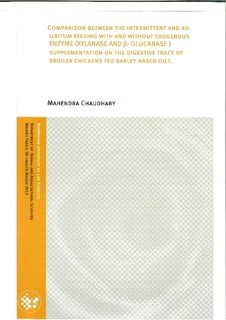| dc.contributor.author | Chaudhary, Mahendra | |
| dc.date.accessioned | 2013-10-21T11:10:22Z | |
| dc.date.available | 2013-10-21T11:10:22Z | |
| dc.date.copyright | 2013 | |
| dc.date.issued | 2013-10-21 | |
| dc.identifier.uri | http://hdl.handle.net/11250/186240 | |
| dc.description.abstract | An experiment was conducted to study the comparison between the intermittent and ad libitum feeding supplemented with and without exogenous (xylanase and β-glucanase) enzyme on the anterior digestive tract of broiler chickens with barley based diet. In an experiment 144 male broiler chickens (Rose 308) were fed barley based diet supplemented with or without exogenous enzyme under intermittent and ad libitum feeding system in a 2 x 2 factorial arrangement with 16 hours of light and 8 hours of darkness for 7 to 35 days of age. Intermittent fed birds had access to feed five times a day with four 1 hour and one 2 hour feeding bout a day from 7 to 12 days of age and five 1 hour feeding bout a day from 12 to 35 days of age. Ad libitum feeding consisted of continuous access to feed. The experiment was terminated on 35 days of age. The sample collected on 34th day of the experiment was used for the comparison between the intermittent and ad libitum feeding system on the anterior digestive tract. The birds were selected randomly and killed exactly after 3 hours of feeding commencement to collect the content of crop, proventriculus-gizzard, duodenum + jejunum and ileum for the determination of dry matter content and intestinal viscosity. No interaction was seen between the feeding regimen and exogenous enzyme in the performance characteristics of broiler chickens. Exogenous enzyme didn’t affect the body weight (BW) gain and feed intake but significantly increased AME (P<0.0001) for 7-21 days of age. Enzyme supplementation reduced feed intake (P=0.0003) and improved feed utilization efficiency (P=0.08) but the body weight (BW) gain and intestinal viscosity was not affected for 21-35 days of age. The crop has been used as a storage organ in intermittent feeding system which helped in the compensatory body weight (BW) gain during the last days of the experiment. In the ad libitum feeding system large variation in the crop and gizzard among the chickens was seen.
In conclusion, the results from this experiment show no difference in the performance of chickens with or without exogenous enzyme in the feeding system. There is no effect of enzyme on the viscosity of digesta from small intestine which may be due to low soluble fiber concentration in barley. The chickens have ability to maintain growth rate during intermittent feeding due to storage capacity of crop. | no_NO |
| dc.language.iso | eng | no_NO |
| dc.publisher | Norwegian University of Life Sciences, Ås | |
| dc.subject | Feeding system | no_NO |
| dc.subject | Broiler chicken | no_NO |
| dc.subject | Exogenous enzyme (xylanase and beta glucanase) | no_NO |
| dc.title | Comparison between the intermittent and ad libitum feeding with and without exogenous enzyme (xylanase and β-glucanase) supplementation on the digestive tract of broiler chickens fed barley based diet | no_NO |
| dc.type | Master thesis | no_NO |
| dc.subject.nsi | VDP::Agriculture and fishery disciplines: 900::Agriculture disciplines: 910::Animal feeding: 918 | no_NO |
| dc.source.pagenumber | 28 | no_NO |
